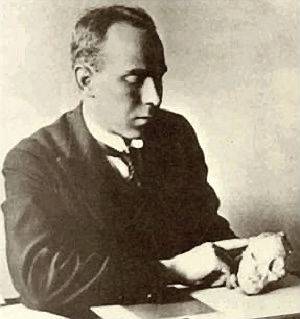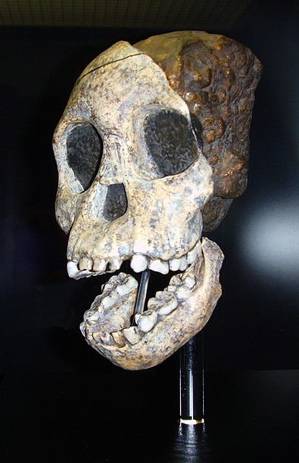Raymond Dart
Biography
|
|
EUGENE M. MCCARTHY, PHD
 Raymond Dart with the Taung skull
Raymond Dart with the Taung skull Taung Child — Replica with mouth open to show teeth.
Senckenberg-Museum, Frankfurt-am-Main, Germany.
Image: Wikimedia
Taung Child — Replica with mouth open to show teeth.
Senckenberg-Museum, Frankfurt-am-Main, Germany.
Image: Wikimedia
Raymond Arthur Dart (1893–1988). Australian-born South African anatomist and paleoanthropologist. The first scientist to recognize an australopithecine, Dart was the discoverer of the Taung Child.
|
|
Raymond Dart grew up on a family farm in Queensland, Australia. One of nine siblings, he had to earn his way in the world and went to the University of Queensland on a scholarship. There, he received high marks before going on to medical school in Sydney. During World War I, he served in uniform as a doctor. Staying on in England for several years after the war, he worked with Grafton Elliot Smith, a prominent anatomist and anthropologist. Then, in 1922, he became a professor of anatomy at the University of the Witwatersrand in Johannesburg, South Africa.
Two years later, in 1924, he found himself examining fossil-bearing rocks blasted from a limestone quarry at Taung, a small town situated in the North West Province of South Africa. Among them them, he found a skullcap, to his anatomist’s eye obviously that of a primate. It fit precisely over a brain-cast protruding from the surface of one of the rocks. After more than a month of patient chipping, he managed to reveal the skull’s face. It was the first specimen of an australopithecine ever found.
Dart named his find Australopithecus africanus (“southern ape of Africa”). He judged the skull to be that of a juvenile individual and it came to be known as the Taung Child. Dart was convinced even then that he had made the “early human find” of the century.
In a paper published in the journal Nature (Dart 1925), he argued that A. africanus represented a missing link between apes and humans since it combined humanlike teeth and upright posture with a small cranial capacity. This assertion was roundly rejected by European anthropologists, in particular by Sir Arthur Keith, who dismissed his South African colleague’s specimen as the skull of a immature ape. Keith himself, however, had been taken in by the Piltdown Man hoax (as had Dart’s former mentor Grafton Elliot Smith) which had led many scientists to believe early humans had apelike jaws and a large brain — the reverse has turned out to be the case.
Moreover, at the time it was generally believed that humans had originally evolved in Asia. This idea of an oriental origin was only strengthened by the much publicized discoveries of Homo erectus remains at Zhoukoudian during the decade following the publication of Dart’s paper. When Dart went to England in 1930 to drum up support for his claims, he found himself overshadowed by Pei Wenzhong’s discovery of a largely intact Homo erectus skull at Zhoukoudian. He was so much ignored in England that he became discouraged. Returning to South Africa he threw himself into his work as head of the anatomy department, and for years thereafter neglected questions of human origins.
However, Robert Broom, a paleontologist at the Transvaal Museum, was excited by Dart’s find and sought him out. Dart later remembered how Broom “burst into my laboratory unannounced. Ignoring me and my staff, he strode over to the bench where the skull reposed and dropped to his knees ‘in adoration of our ancestor.’”
(1866–1951)
Dart and Broom became friends and in 1936 Broom decided he, too, would search for australopithecines. That same year he unearthed the fragmentary skull of an adult australopithecine at Sterkfontein cave. In 1938, he described and named a new hominid of his own, Paranthropus robustus (Broom 1938). It was based on a skull found at Kromdraai, another site in South Africa.
In the 1940’s Dart returned to fossil hunting — in part inspired by Broom, the man he had himself inspired — and found more australopithecine remains in a cave at Makapansgat, also in South Africa.
Broom, too, made additional finds, but a monograph on australopithecines that he co-authored with G. W. H. Schepers (Broom and Schepers 1946) was perhaps more significant than any of his fossil discoveries. It convinced many paleoanthropologists of what Dart had been claiming all along — that australopithecines were ancestral to modern humans.
In the end, Raymond Dart reached the age of 95 and lived to see the Leakeys, building on his work and that of Broom, fully convince the scientific world that he had been correct in asserting that human evolution began in Africa.
In the end, Keith was forced to admit — “Dart was right, and I was wrong.”
Download:
Dart, R. A. 1925. Australopithecus africanus: the man-ape of South Africa. Nature, 115:195-9.
(793 Kb download of Raymond Dart’s first report of the discovery of the Taung skull).
A note about Raymond Dart: Raymond Dart is also remembered for his killer ape theory, in which he proposed that a line of carnivorous apes branched off the simian tree and later evolved into humans (Dart 1953). The hunting habit, supposedly, led these new primates not only to tool use and success, but also to the killing of their own kind. Dart’s killer ape theory was promoted by Robert Ardrey in his book African Genesis (1964), but it never gained wide acceptance, and is generally dismissed today.
Raymond Dart’s dates of birth and death: February 4, 1893 — November 22, 1988.
Most shared on Macroevolution.net:
Human Origins: Are we hybrids?
On the Origins of New Forms of Life
Mammalian Hybrids
Cat-rabbit Hybrids: Fact or fiction?
Famous Biologists
Dog-cow Hybrids
Georges Cuvier: A Biography
Prothero: A Rebuttal
Branches of Biology
Dog-fox Hybrids